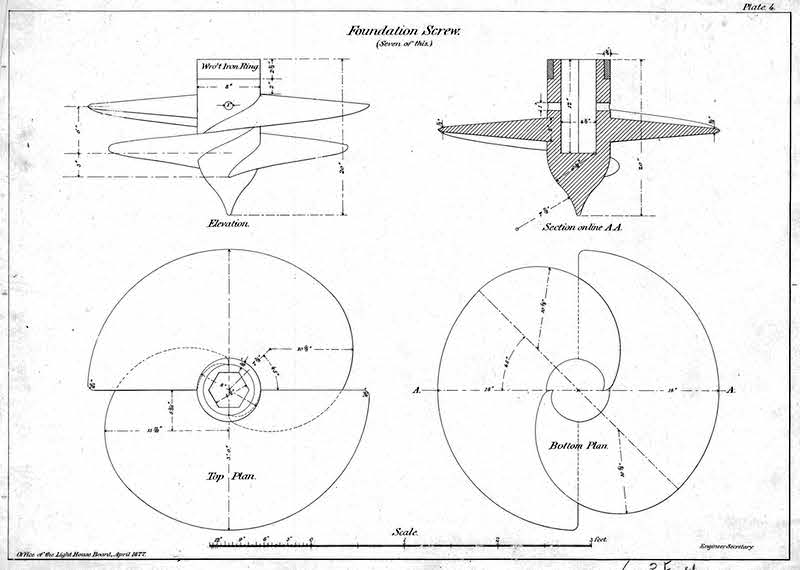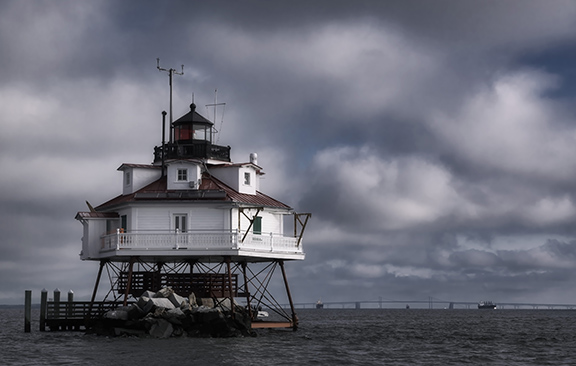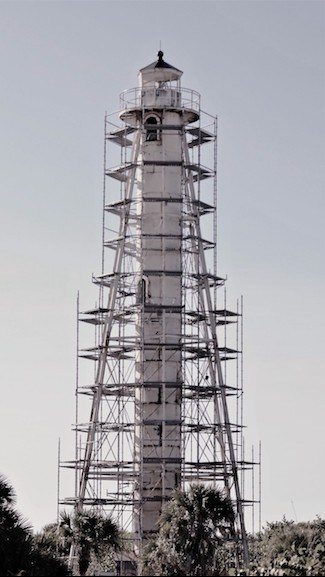Kate Walker here, keeping the light on Robbins Reef.
There were a lot of locations where the heavy tall towers I talked about earlier couldn’t be built. If the bottom was muddy or sandy, as in the Chesapeake Bay, Delaware Bay, the Gulf of Mexico, the Mississippi River delta, and the coral reefs of the Florida Keys, the development of newer technology using screwpile, caisson, and skeletal tower lighthouse construction was essential to adequately warn navigators of the shoals and currents offshore.

Screwpile lighthouses were either low spider-like foundations for rivers, bays, and sounds, or tall offshore coastal towers. Perhaps as many as 100 spider-like screwpile lighthouses were built throughout the Carolina sounds, the Chesapeake Bay, Delaware Bay, along the Gulf of Mexico, and one even at Maumee Bay (1855) on Lake Erie in Ohio. Most had wooden keeper’s dwellings, although Seven Foot Knoll in Maryland had a cast iron dwelling.


Onshore skeletal towers were built of cast iron and were typically constructed on concrete foundations. Manitou Island Lighthouse (1861) and Whitefish Point Lighthouse (1861), Michigan, both built from the same plan, are the earliest onshore skeletal towers built in the United States. Like the cast-iron-plate tower, skeletal towers could be dismantled and moved.
Offshore skeletal towers were also built of cast iron and typically constructed with straight or screwpile foundations. A few offshore screwpile skeletal tower lighthouses built on coral reefs used foot plates or disks to help disperse the weight of the tower. Examples in the Florida Keys include Carysfort Reef Lighthouse (1852), Fowey Rocks Lighthouse (1878), and American Shoal Lighthouse (1880).

 All this interesting information is from the National Park Service Maritime Heritage Program, Historic Lighthouse Preservation Handbook, released in August 1997, created through a cooperative partnership between the National Park Service, U.S. Coast Guard, Department of Defense Legacy Resource Management Program, and U.S. Lighthouse Society.
All this interesting information is from the National Park Service Maritime Heritage Program, Historic Lighthouse Preservation Handbook, released in August 1997, created through a cooperative partnership between the National Park Service, U.S. Coast Guard, Department of Defense Legacy Resource Management Program, and U.S. Lighthouse Society.
Submitted December 28, 2017
* * * * *
U.S. Lighthouse Society News is produced by the U.S. Lighthouse Society to support lighthouse preservation, history, education and research. Please join the U.S. Lighthouse Society if you are not already a member. If you have items of interest to the lighthouse community and its supporters, please email them to candace@uslhs.org.


Hi Keeper_Kate,
Thanks for your informative posts, my partner and I have enjoyed reading them! We are currently based on Maatsuyker Island, Tasmania (Australia). We are here for 6 months in isolation, caretaking the island/buildings/lighthouse.
The lighthouse is a First Order light and is fully functioning (we operate it without the light, it was decommissioned and replaced by a modern light in a different location). Over 540 pieces of handmade glass make up the lens. The mechanism is a work of art.
We are interested in other care-taking opportunities/employment around the world, there doesn’t seem to be much available. I’m sure you will be interested in seeing some of our photos/videos, we have an instagram page (www.instagram.com/thelighthousekeepers).
Cheers!